 W
WIn insect anatomy the arista is a simple or variously modified apical or subapical bristle, arising from the third antennal segment. It is the evolutionary remains of antennal segments, and may sometimes show signs of segmentation. These segments are called aristameres. The arista may be bare and thin, sometime appearing no more than a simple bristle, pubescent - covered in short hairs, or plumose - covered in long hairs.
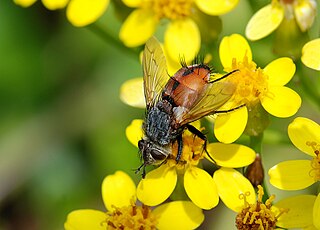 W
WA calypter is either of two posterior lobes of the posterior margin of the forewing of flies between the extreme posterior wing base and the alula, which covers the halteres.
 W
WCampaniform sensilla are a class of mechanoreceptors found in insects, which respond to stress and strain within the animal's cuticle. Campaniform sensilla function as proprioceptors that detect mechanical load as resistance to muscle contraction, similar to mammalian Golgi tendon organs. Sensory feedback from campaniform sensilla is integrated in the control of posture and locomotion.
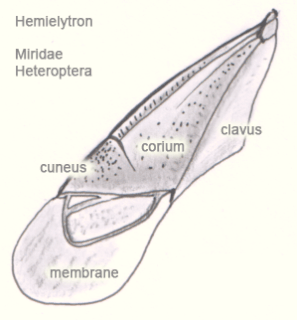 W
WThe corium is the thickened, leathery, basal portion of an insect forewing or hemelytron in the order hemiptera. Specifically the inner cell of the basal portion is the corium.
 W
WThe cornicle is one of a pair of small upright backward-pointing tubes found on the dorsal side of the 5th or 6th abdominal segments of aphids. They are sometimes mistaken for cerci. They are no more than pores in some species.
 W
WThe gaster is the bulbous posterior portion of the metasoma found in hymenopterans of the suborder Apocrita. This begins with abdominal segment III on most ants, but some make a constricted postpetiole out of segment III, in which case the gaster begins with abdominal segment IV.
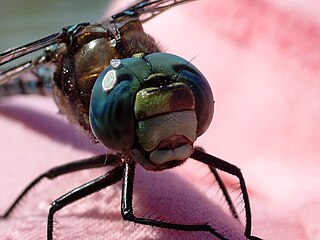 W
WHoloptic refers to one of the ways in which the Arthropod eye develops, particularly the eyes of various species of insects. As opposed to dichoptic and cycloptic eyes, holoptic eyes meet along the median dorsal line of the head, in many species nearly covering the exterior of the head. Holoptic eyes are typical of several Dipteran males, in particular some Syrphidae, Tabanidae, Pipunculidae, and Acroceridae. Some other insect orders that include species with holoptic males and some in which the females are holoptic as well, include the Coleoptera, Anisoptera and Archaeognatha.
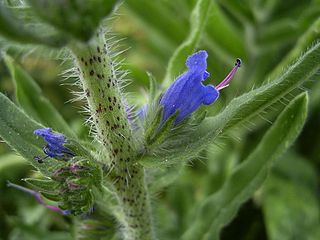 W
WIn biology, an indumentum is a covering of trichomes on a plant or of bristles of an insect.
 W
WIn insect anatomy, the juxta is an organ in the males of most Lepidoptera that supports the aedeagus, the organ used for reproduction in insects. The juxta is located between the two valvae. Juxta has also been used to refer to a similar structure in fleshflies.
 W
WIn entomology, the term labellum has been applied variously and in partly contradictory ways. One usage is in referring to a prolongation of the labrum that covers the base of the rostrum in certain Coleoptera and Hemiptera.
 W
WThe mesosoma is the middle part of the body, or tagma, of arthropods whose body is composed of three parts, the other two being the prosoma and the metasoma. It bears the legs, and, in the case of winged insects, the wings.
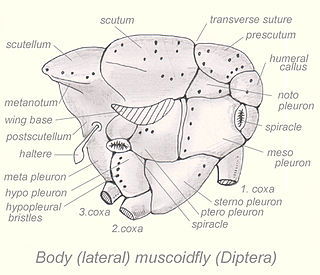 W
WThe notopleuron is a region on an insect thorax. Notopleura are useful in characterizing species, particularly, though not uniquely, in the Order Diptera. The notopleuron is a thoracic pleurite situated at the end of the transverse suture of Diptera.
 W
WA proleg is a small, fleshy, stub structure found on the ventral surface of the abdomen of most larval forms of insects of the order Lepidoptera, though they can also be found on other larval insects such as sawflies and a few other types of insects. In all the orders in which they appear, mainly Hymenoptera and Lepidoptera, prolegs of any form evolved independently of each other by convergent evolution.
 W
WIn flies of the order Diptera, the prostigma is the anterior of the two pairs of spiracles opening on the pleura. The mesothoracic (anterior) pair is located between the pro- and mesothorax and the metathoracic pair between the meso- and metathothorax. The following illustration shows the prostigma as number 13 on the right side of the image. The function of the prostigma is to provide an airway into the insect's thorax to facilitate respiration.
 W
WThe prothorax is the foremost of the three segments in the thorax of an insect, and bears the first pair of legs. Its principal sclerites are the pronotum (dorsal), the prosternum (ventral), and the propleuron (lateral) on each side. The prothorax never bears wings in extant insects, though some fossil groups possessed wing-like projections. All adult insects possess legs on the prothorax, though in a few groups the forelegs are greatly reduced. In many groups of insects, the pronotum is reduced in size, but in a few it is hypertrophied, such as in all beetles (Coleoptera), in which the pronotum is expanded to form the entire dorsal surface of the thorax, and most treehoppers, in which the pronotum is expanded into often fantastic shapes that enhance their camouflage or mimicry. Similarly, in the Tetrigidae, the pronotum is extended backward to cover the flight wings, supplanting the function of the tegmina.
 W
WThe ptilinum is an eversible pouch on the head, above the base of the antenna in schizophoran flies. It is used to force off the end of the puparium in order for the fly to emerge, and after this inflation at emergence, the ptilinum collapses back inside the head, marked thereafter only by the ptilinal suture or frontal suture.
 W
WThe term raptorial implies much the same as predatory but most often refers to modifications of an arthropod's foreleg that make it function for the grasping of prey while it is consumed, where the gripping surfaces are formed from the opposing faces of two successive leg segments.
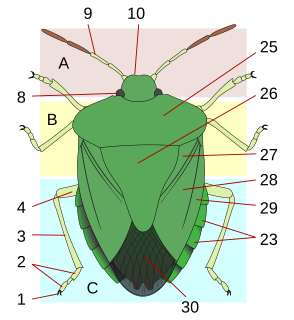 W
WThe scutellum is the posterior portion of either the mesonotum or the metanotum of an insect thorax; however, it is used almost exclusively in the former context, as the metanotum is rather reduced in most insect groups. In the Hemiptera, and some Coleoptera, the scutellum is a small triangular plate behind the pronotum and between the forewing bases. In Diptera and Hymenoptera the scutellum is nearly always distinct, but much smaller than the mesoscutum.
 W
WA siphon is a tubular organ of the respiratory system of some insects that spend a significant amount of their time underwater, that serves as a breathing tube.
 W
WIn biology, a sterigma is a small supporting structure.
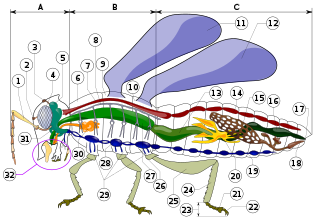 W
WThe suboesophageal ganglion of arthropods and in particular insects is part of the arthropod central nervous system (CNS). As indicated by its name, it is located below the oesophagus, inside the head. As part of the ventral nerve cord, it is connected to the brain and to the first thoracic ganglion. Its nerves innervate the sensory organs and muscles of the mouthparts and the salivary glands. Neurons in the suboesophageal ganglion control movement of the head and neck as well.
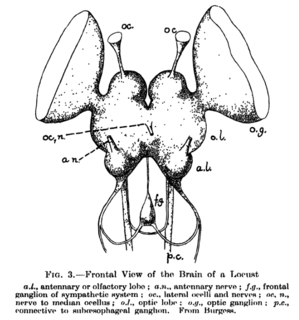 W
WThe supraesophageal ganglion is the first part of the arthropod and (especially) insect central nervous system. It receives and processes information from the first, second, and third metameres. The supraesophageal ganglion lies dorsal to the esophagus and consists of three parts, each a pair of ganglia that may be more or less pronounced, reduced, or fused depending on the genus:
 W
WTarsal formula is the number of segments of the tarsi, which has 3 numbers a-b-c, starting with the fore leg (a), then the middle leg (b), then the hind leg (c). For example, a tarsal formula of "5-5-4" means there are 5 segments in the fore leg's tarsi, 5 segments in the middle leg's tarsi, and 4 segments in the hind leg's tarsi. This character is especially useful at family rank and higher.
 W
WThe thorax is the midsection (tagma) of the insect body. It holds the head, legs, wings and abdomen. It is also called mesosoma or cephalothorax in other arthropods.
 W
WTracheole (trā'kē-ōl') is a fine respiratory tube of the trachea of an insect or a spider, part of the respiratory system.
 W
WTrichobothria are elongate setae ("hairs") present in arachnids, various orders of insects, and myriapods that function in the detection of airborne vibrations and currents, and electrical charge. In 1883, Friedrich Dahl observed that they were deflected by the sound waves from a violin and labelled them 'hearing hairs'.